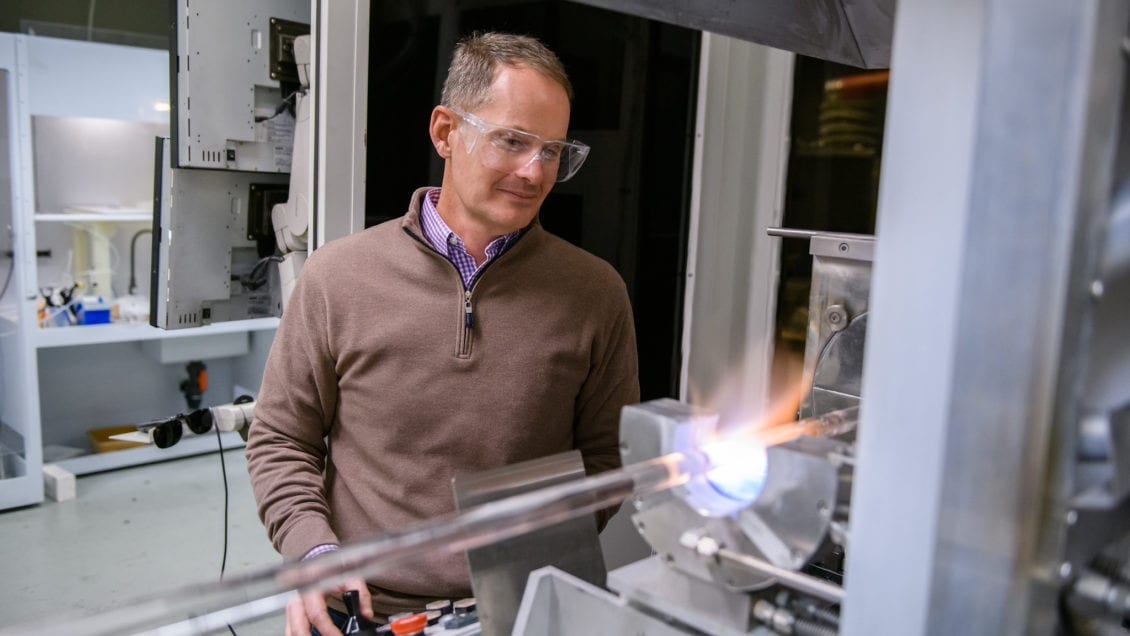John Ballato of Clemson University is in the spotlight as engineers and scientists around the world kick off the United Nations International Year of Glass, a promotion aimed at underscoring the scientific, economic, and cultural roles of glass.
The UN General Council gave formal approval to the yearlong event in May 2021, based on a draft resolution that had been endorsed by over 1,100 companies, associations, museums, journals and academic institutions, including Clemson, altogether representing 74 countries.

Thousands of events and commemorative publications are being planned around the world, including those of the American Ceramic Society (ACerS).
As part of the society’s celebrations, its journal editors selected articles from its 100-year history of glass science publications to highlight those that “have played historically critical roles in advancing glass science and technology and are setting future directions for the field.”
Ballato was the lead author on two of the five papers selected for the “optical fiber and photonics” category out of the hundreds of articles on this topic dating back to the 1970s, when optical fibers were in their infancy. Ballato holds the J. E. Sirrine Endowed Chair in Optical Fiber in Clemson’s Department of Materials Science and Engineering.
Kyle Brinkman, chair of the department, said the selections help raise the University’s international profile.
“This recognition showcases the high level of impact that Dr. Ballato brings to the University and helps bring international attention to Clemson’s leadership in developing innovative forms of glass optical fiber,” Brinkman said “I congratulate him on this well-deserved achievement.”
The two papers highlighted by ACerS were 2016’s “Glass: The Carrier of Light – A Brief History of Optical Fiber” and 2021’s “Glass: The carrier of light – Part II – A brief look into the future of optical fiber.” Both were co-authored with Peter Dragic, an assistant professor at the University of Illinois at Urbana-Champaign.
“It’s an honor to be recognized by my peers and to have these papers selected by ACerS to help kick off the International Year of Glass,” Ballato said. “Dr. Dragic and I make a good team, and I want to acknowledge the important role he played in producing these papers. I look forward to continuing to promote the important role of glass in society in 2022 and beyond, and Clemson’s leading roles in it.”
Founded in 1898, ACerS is the world’s foremost professional society focused on ceramics and glasses and includes more than 11,000 members worldwide.
Ballato’s work focuses on fiber optics and understanding how light interacts with materials. He joined the University in 1997 as a professor in what was then the ceramic engineering department and is credited with developing Clemson’s world-class fiber optics research and development program.
His work in the field has helped set Clemson apart as a leader in fiber optics research for the public and private sectors. He has developed specialty optical fibers for high-energy laser, biomedical and industrial uses.
In 2000, Ballato and four colleagues founded the Center for Optical Materials Science and Engineering Technologies (COMSET), a large-scale, interdisciplinary collaborative research center. For 14 years, he served as COMSET director and continues to work with the center as faculty and as a mentor.
Ballato’s work with the center has helped to elevate Clemson as the only university in the United States, and one of only a handful in the world, that has the industry scale capability to make optical fiber.
Ballato is a fellow of the American Association for the Advancement of Science, the American Physical Society, the Institute of Electrical and Electronics Engineers, the Optical Society, the International Society of Optical Engineering, and the American Ceramic Society, Ballato has over 450 publications and 35 U.S. and foreign patents. He is an elected member of the World Academy of Ceramics and the U.S. National Academy of Inventors.
His work on Anderson localizing optical fiber was selected as one of the Top Ten Breakthroughs of 2014 by Physics World. More recently, media coverage associated with his 2020 collaborative work on laser cooling in optical fiber, led by Stanford University, was viewed by over 5 million people worldwide.
Get in touch and we will connect you with the author or another expert.
Or email us at news@clemson.edu

